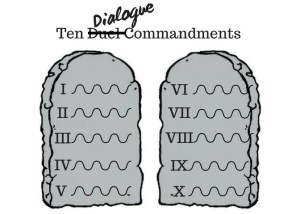
I recently did a presentation on writing realistic dialogue for my local writers group. I decided to go ahead and post it here in case people who had to miss the meeting wanted a chance to read it. Then I thought you guys might like it, too. And if you end up singing Ten Duel Commandments to yourself for the rest of the day, you’re welcome.
And here are links if you missed parts one, two, and three.
Well-written dialogue is an amazing multipurpose tool – it’s a heavy-lifter. It’s the Swiss Army knife in a writer’s toolbox. It can convey character, emotion, and motivation all in a few carefully chosen words. It can also drive the plot. Poorly written dialogue is also a tool – usually a sledgehammer beating against the reader’s head.
It’s no secret that acquiring editors frequently scan for dialogue in submissions. And when it doesn’t work, they often pass on a manuscript without reading further.
I’ll admit that when I was working as an acquisitions editor, I always made a point to see how the author handled dialogue. If it was rife with the dialogue sins we’re about to discuss, the author received a rejection letter. If the dialogue had potential, I’d read more of the story and possibly send a revise and resubmit letter. If the dialogue was solid and engaging, I’d often read the entire submission. The moral of this story is that good dialogue will get you a lot farther.
#7 Thou shalt avoid repetition in your internal and external dialogue.
Often in fiction, a you’ll see a character thinking or saying that they need to do or say something. Then immediately doing and saying them.
Don’t. Just…don’t.
I think that this might happen because authors have been given the advice to include more thoughts and feelings in their stories to create depth and foster a connection with the reader. This is often great advice. However, a thought with repeated dialogue or action just a moment later doesn’t add any depth. Only annoyance.
Speaking of annoyance, let’s go back to the most irksome couple of the year, Abbi and Charles and look at some examples with both internal and external dialogue.
“C’mon.” Charles smiled and tugged at her.
She yanked her hand from his grip. She really needed to tell him to leave. “Just go away,” Abbi said.
“I don’t see why you have to be this way.” He frowned and backed from the room.
Abbi sighed. She wasn’t being any kind of a way. She just didn’t want to go. If she were smart, she’d get up and lock the door to keep him from coming back to bug her. Abbi got up and locked the door.
Pretty annoying, right? I know a reviewer for whom this is a book throwing pet peeve. Again, this is one of those things that makes the reader feel that the author doesn’t trust them to be intelligent enough to follow the narrative. Often, the writer may not even be aware they’re doing it. That’s usually the case when I point it out to clients. But when this repetition happens in a story, it comes across to the reader like, “Oh my sweet, summer child. You are dim-witted and in need of guidance. Come take my hand, and let me lead you though this narrative.”
No one likes that.
#8 Thou shalt not allow talking heads in your manuscript.
Editors often refer to a back and forth exchange of dialogue with no action or thought as “talking heads”. It’s as if the characters freeze whenever they begin speaking and do nothing else but recite their lines.
The problem with this is even if the dialogue is good, it will still read woodenly. Your characters need be fully realized people and that means that they do things like check their phones or the time, fiddle with the labels on beer bottles, shift from foot to foot, wonder if they can leave early, wonder if now is the right time to break up, notice that they’re hungry, etc. Anything that both fits the character and helps move the story forward will work, but they need to be doing and thinking something.
Also, it’s important that your characters aren’t interacting with each other in a vacuum. This is where the setting comes in and should be utilized as part of the actions and thoughts that ground the dialogue in reality. Let’s say your characters are talking over a round of drinks. Are they having a beer on the front porch swing? Are they in an intimate booth in a quiet pub? Or are they at a loud, crowded club? How does the location impact their actions, thoughts and conversation?
This was a pretty short set of commandments this week, but check back next week for the last part of the series!

I actually think I have the opposite problem to #8. I put in way too much action between lines of dialogue and have to go back and have my characters sit down, stop fiddling and just spit it out, already.
I love how well you’re explaining these. Can’t wait for the last instalment!
I’m cracking up at #7, when characters think an action and then do that action. My rough drafts look exactly like this! As I’m feeling my way through the story, my characters always think before they do, because as an author, I’m thinking before I write.
But this is why I edit! My second drafts are so much better because I get all that extra thought outta there.